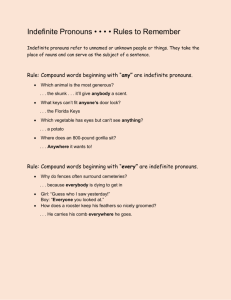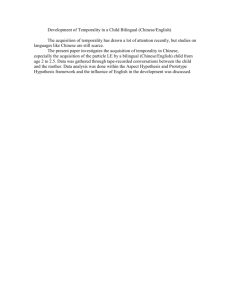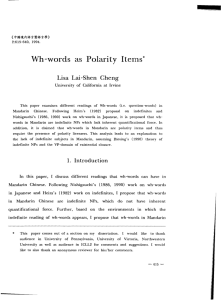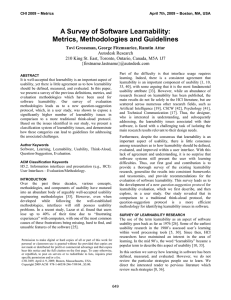Learnability Theory
advertisement
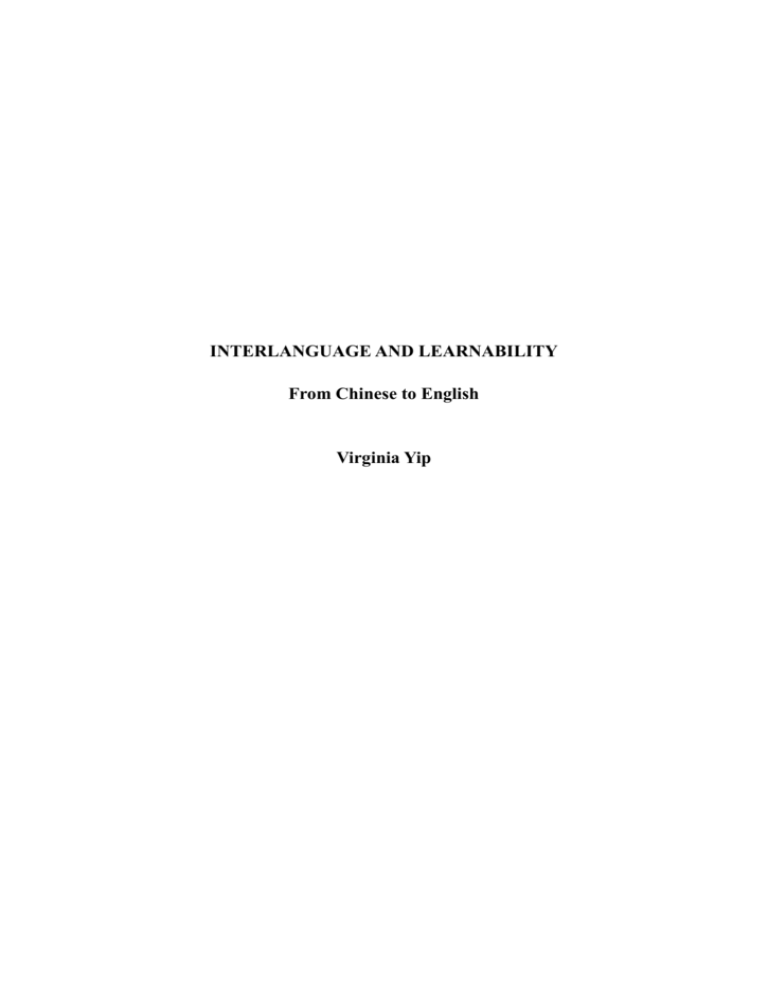
INTERLANGUAGE AND LEARNABILITY From Chinese to English Virginia Yip Chinese-English Interlanguage ( CIL) Pseudo-passives: New cars must keep inside. These ways almost can classify two types. Ergative Constructions: What is happened with these verbs? Our offspring will be suffered because we neglect the environment pollution. Tough Movement: I am difficult to learn English. Foreigners are easy to be misunderstood. Existential Constructions: There are many varieties of cancers exist. There are episodes in the fiction tell the readers about the discussion. Learnability Theory Learnability Theory To explain how a language learner progresses from one state of knowledge to another based on language input. Gold (1967) Formal Learnability theory could be very mathematical. If Pi is a parameter with values Vi1, Vi2 …Vin such that, for some parameter assignment P, L(PVi1)[L(PVi2)[…[L(PVin), then Vi is unmarked relative to Vi for every 1<m<n-1. The Logical Problem of L1 and L2 Acquisition L1:Why all children manage to acquire L1 despite the degenerate nature of the input? L2: 1. same as L1; 2. Why people fail to learn despite the available evidence? (Orwell’s Problem, the problem of unlearnability). Association with UG Concerns with Overgeneration Elements of L1 Learnability model (Gregg, 2001) The initial state of the learner The final state of the learner Input Learning mechanism An evaluation metric Elements of adult L2 Learnability model (Gregg, 2001) The adult L2 learners’ initial state vis-a vis the L2 The L2 learner’s final state L2 input L2 learning mechanism Evaluation metric The Nature of Input positive negative direct triggering data explicit correction indirect If P then – Q (Catapult Hypothesis) Non-occurrence The Problem of Overgeneration How learners manage to revise their over-general grammar without negative evidence (No Negative Evidence Hypothesis for L1) Learning Mechanism (based on ‘no negative evidence’ hypothesis) To explain the interaction with UG on one hand, and input on the other 1. Subset Principle “The learning function maps the input data to that value of a parameter which generates a language: a. compatible with the input data; and b. smallest among the languages compatible with the input data ”(Wexler and Manzini, 1987) H T T H Learners select the subset grammar, the most restrictive hypothesis L1 perspective: A preventive measure that guards the learner from over-general grammars which would require negative evidence to disconfirm them. L2 perspective(Yip, 1995): “An analytical tool, a logical principle of learnability rather than a learning principle Interlanguages frequently represent supersets with respect to the target grammar, typically under the influence of transfer.” Overgeneration: CIL as superset, English as subset Undergeneration: CIL as subset, English as superset The Subset Principle in L2 Is SP relevant to SLA? The problem of transfer: SLA studies “When the Il generates s superset in relation to the target language with respect to a hypothesis, construction or parameter-setting, the SP Principle predicts the situation to be unlearnable in the absence of negative evidence” (in case the hypothesis is too narrow, positive evidence in the input will suffice to inform the learner to move on to a more general hypothesis). (Yip) 2. Preemption: Uniqueness Principle (Wexler, 1979) A given meaning in a language may have only one form. When two forms are perceived as having the same meaning, one of them preempts the other. If the learner has erroneously created a form through some productive mechanism, the appearance of an alternative realization of that form in the input will be sufficient to preempt the erroneous one. Intended as a means for the learner to eliminate incorrect forms from IL. (e.g. eated ate) Problems with UP 1. While Up seems plausible when applied to lexical items or inflectional morphology, it seems hard to apply to syntax. 2. In L2, Il ungrammatical forms yielded by transfer appear to be more resistant to preemption (leading to fossilization). 3. Linguistic maturity and tolerance of synonymy 4. as with SP, lack of empirical data to support its operation SP and UP as complementary components of L2 Learnability IL (superset) preempted on the basis of UP Students’ Composition There are white clouds floated in the sky. There are many people grew up with her. There are many things happened to me. There are several kinds of sports are my favorites. There aren’t different between living in village or town. There are many things impressed me. There are something is important in Chinese. There are a lot of fathers have to make dinner for the family. There are many dishes have special meaning. Existential Constructions and Indefinite Subjects Existential pseudo-relatives There are many varieties of cancers exist. There are episodes in the fiction tell the readers about the discussion. There is a tire hanging from the roof served as their playground. There were many new patriots in my country gathered together and established a new country. Regularity of existential sentences in Chinese ESL students’ composition “average of 4 in every 5 compositions” CIL structure There NP VP there be as topic introducer (Rutherford, 1983) Comment Topic EXIST NP VP Subject Predicate Chinese Pivotal Constructions: (NP serving as pivot linking two verbs) Zhangsan zhize Lisi dashang-le Wangwu. Thangsan accuse Lisi of wounding Wangwu. (NP)1 V1 NP2 (XP) Chinese Existential Sentences appear in the form of pivot structure: You hen duo ren xihuan yufa. Why Chinese students overgenerate existential sentences? 1. transfer of the pivot constructions 2. avoid indefinite NP in subject position (one preferred position for indefinite NPs in Chinese is the position after an existential verb, you) Definiteness of Subjects There is a book on the table. *There is the book on the table. *Yige ren zai yuenzi li zuoshe. You yige ren zai yuenzi li zuozhe. Chinese vs. English: 1. English allows indefinite NPs to occur relatively freely in the subject position. 2. As a result, the transfer of DE in Chinese poses a learnability problem in the acquisition of English indefinite subjects. 3. Native speakers would not use there be sentences in many contexts where Chinese speakers would. (English has a rather restricted range of application.) How to acquire the target structure? 1. Use English relative: There are many things (which) impressed me. 2. Use participal constructions: There are white clouds floated (floating) in the sky 3. Use indefinite NPs in the subject: (There are)Many tourists visit there. Learnability Problem: 1. SP Principle :CIL as the superset, no evidence for the ungrammaticality of the overgenerated there be sentences. CIL there be English there be 2. Difficulty in acquiring English indefinite subjects: a. insufficient positive evidence for restructuring undergeneration : About 10% of the subjects of main-declarative-affirmative sentences (nonpresentative) are indefinite, as against 90% definite. (Givon, 1979). English Indefinite subjects CIL Indefinite subjects b. Uniqeness Principle impedes acquisition: “as long as the learner holds onto the distinction between definite and indefinite subjects, UP would dictate the mapping of indefinite NPs onto a separate form, i.e., the existential construction.



